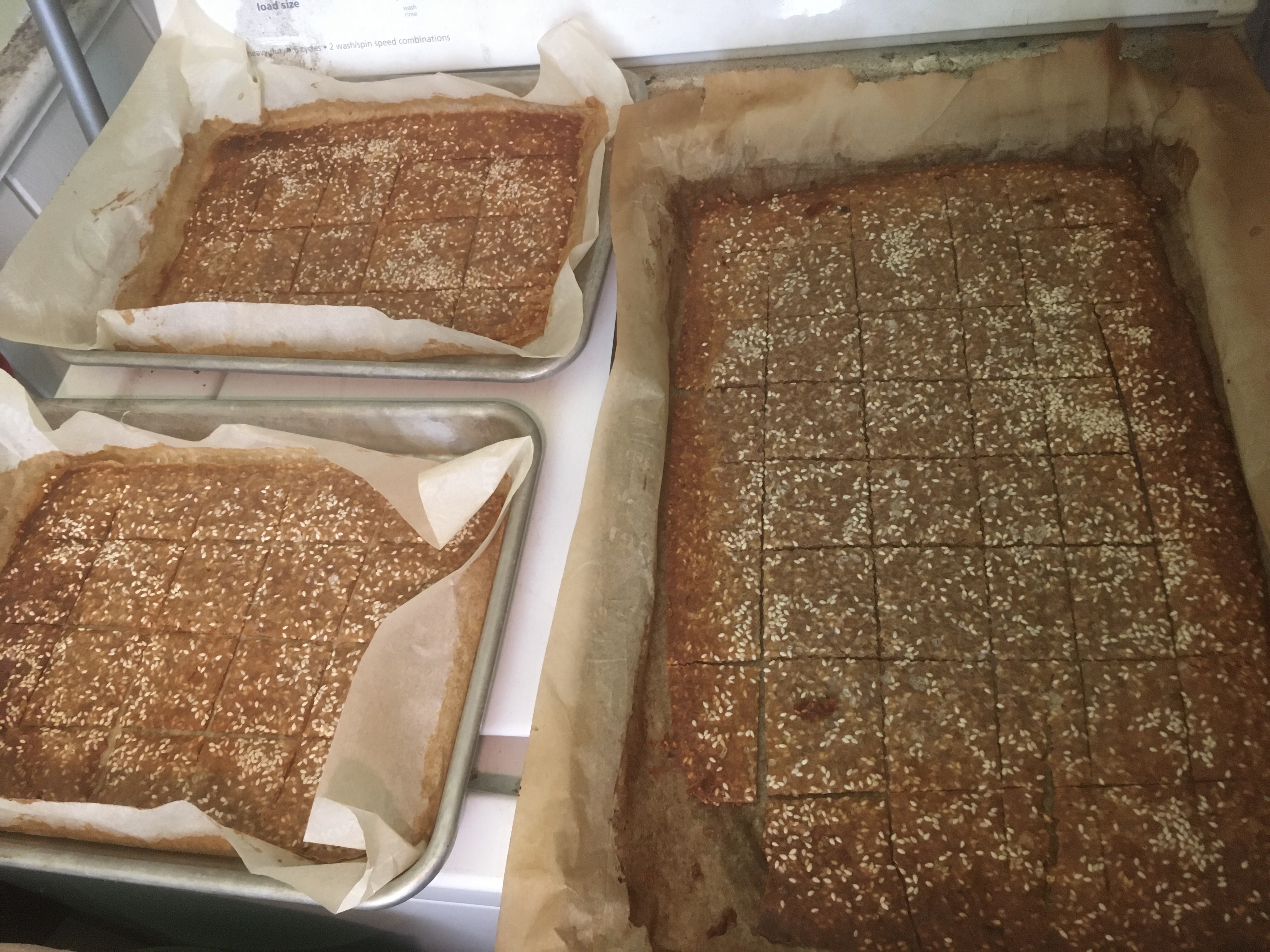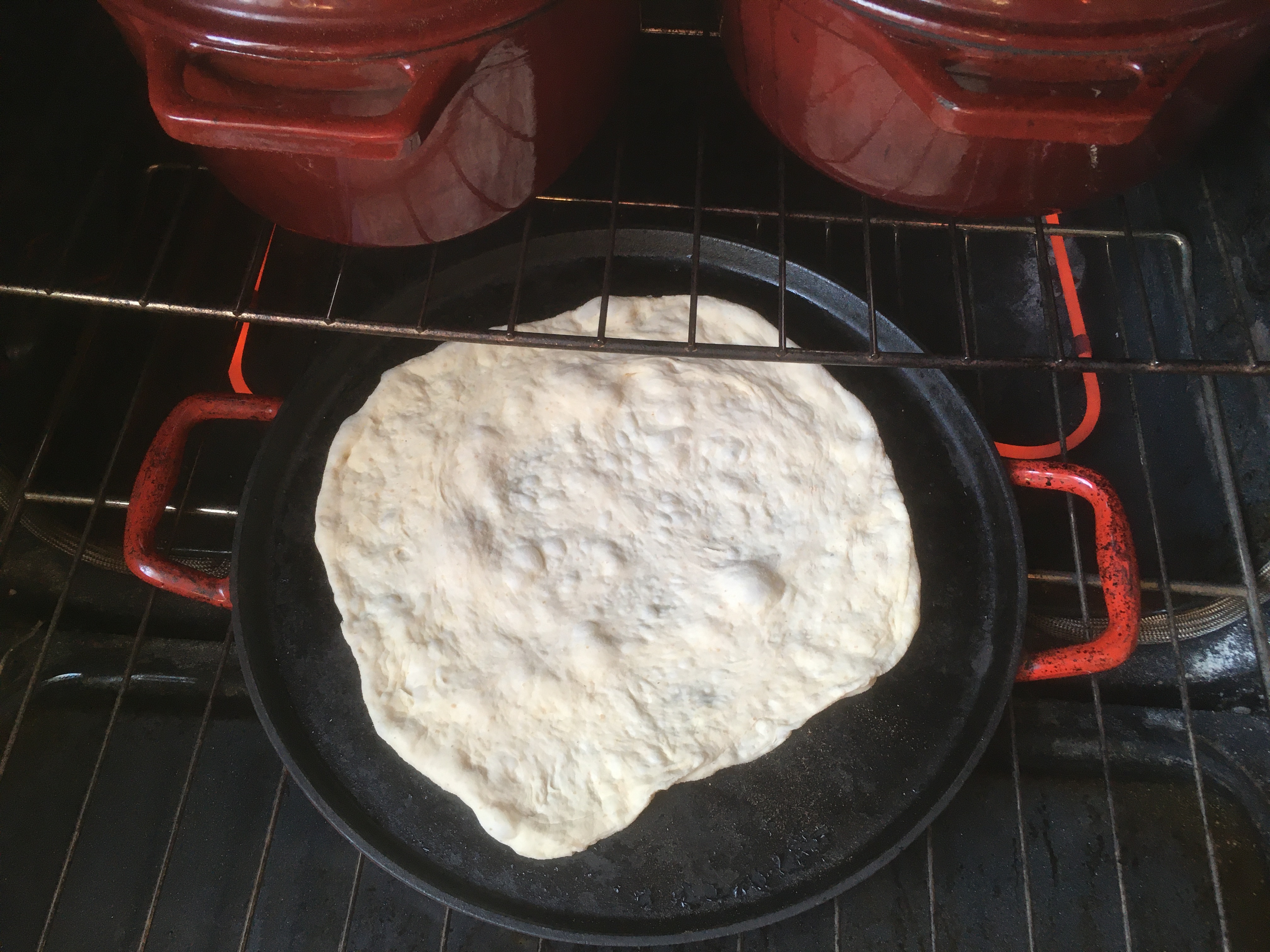
These recipes use discard starter, and make a pourable batter rather than a dough that you have to rise and roll out. Easy! Just spread it out evenly and bake.
For best results, the sourdough discard should be at 100% hydration. This means that you need to feed your starter with equal amounts of flour and water – 1:1:1 existing starter, flour, and water. I usually discard (or use up) all but 100g of starter, and feed it with 100g of water and 100g of flour (usually whole wheat, but sometimes rye or white, or whatever you have on hand will do). 1:1:1 makes 100% hydration starter, because amount of water used is 100% the amount of flour, by weight.
I have been asked if it is necessary to stir down sourdough starter before using it in a recipe. If you’re using sourdough starter to leaven bread, don’t stir it down – you want those bubbles to rise the bread. For crackers, however, you can stir it down, or not bother – you’re going to whisk the batter, and that will stir down any air bubbles that may exist.
Lately I have been feeding my starter with whole wheat flour, so my crackers are 100% whole wheat. They browned a little more than crackers made with white flour, but they have more flavour, and are practically health food (at least, that what I’m telling myself). These are not saltines, and don’t look or taste like saltines.
There is a pronounced sourdough flavour to these crackers, and I like it. They are deeply savoury. As they baked, the aroma and steam of the sourdough would roll out of the oven when I opened the oven door. Very tangy!
So far, I have just eaten the crackers right out of the pan, but they would be good with cheese or charcuterie or dips too. I find that, similar to sourdough bread, when I get that sour flavour on my palate, I crave more of it. Good thing I made several batches of crackers!
It is important that the batter is spread thinly and evenly over the baking sheet. I used one 12×18” cookie sheet and two 9×13” cookie sheets, and baked two batches at a time. If it is uneven, the thin spots will burn while the thick spots will be chewy.
The recipe variations that have cheese are thicker and take more work to spread evenly; the other versions pour out of the mixing bowl, and can be evened-up by shaking the pan after you spread the batter out. My pans are not new, and are a little warped, which I think explains why it was difficult to get the batter evenly spread.
I have made all of the variations below, and have found that the versions that use butter burn more easily. I have modified the recipes to use half melted butter and half olive oil – best of both worlds. Watch them carefully, and be prepared to take them out early, if needed. Your oven might have hot spots, or the thermostat might not be accurate.
The butter versions are good (I will never publicly admit that butter isn’t better) but they are very rich, because they also have cheese. I guess I should have tried to create a butter version that didn’t include cheese, but I used up all my discard starter today (all 3 quarts of it!), so that’s a project for another day.
I made crackers flavoured with pesto and garlic aioli because I found 2 different dip mixes in the back of my spice cupboard, and thought they would make good crackers. The pesto dip mix I have was quite flavourful, and it’s possible that I used too much of it. I was hoping for a vegetable-thins sort of flavour, and they are a little strong. If you have a dip mix you want to use, try it – I was thinking about a ranch-flavoured cracker, and this was as close as I came. The pesto dip mix has a lot of herbs in it, and, combined with the whole-wheat starter, browned to a dark gray colour that was off-putting at first, but tastes good. These are not saltines, and don’t look or taste like saltines.
Many of my pans of crackers were thinner at the edges than in the middle (again, because I think my pans are a little warped). I took them out of the oven when the outer edges were browned, and then once they cooled some of the interior crackers crisped up a little. Some of the crackers in the middle of the pan were a little thicker, and stayed chewy, so I put them back in the oven a little longer, and they crisped up eventually. I kind of like a little chew, but it’s not conventional.
A final note: for the recipes with butter and cheese, you may want to use unsalted butter, or skip the addition of salt to the batter, especially if you plan to sprinkle a little sea salt to the tops of the crackers before they go in the oven. Most cheeses have salt, and you don’t want your crackers to be too salty. I like the added crunch of sea salt, and I don’t usually buy unsalted butter (although I had some, and used it today), so in future I will omit the salt in the batter.









Here are the recipes:
Rosemary Sourdough Crackers
- 350g sourdough starter discard
- 65g olive oil
- 5g salt
- 4 tsp rosemary
Sesame Sourdough Crackers
- 350g sourdough starter discard
- 65g olive oil
- 5g salt
- 2-4 tbsp sesame seeds (depending on how sesame-y you like them)
Pesto Sourdough Crackers
- 350g sourdough starter discard
- 65g olive oil
- 5g salt
- 4-5 tsp pesto dip mix (or whatever dip mix you have on hand)
Garlic Aioli Sourdough Crackers
- 350g sourdough starter discard
- 65g olive oil
- 5g salt
- 1 tbsp garlic aioli powder (you could try a smaller amount of garlic powder)
Pecorino & Butter Sourdough Crackers
- 350g sourdough starter discard
- 30g olive oil
- 30g melted butter, cooled to room temp*
- 5g salt
- 75g Pecorino Romano, finely grated (could substitute Grana Padano or Parmesan)
Cheddar & Butter Sourdough Crackers
- 350g sourdough starter discard
- 30g olive oil
- 30g melted butter, cooled to room temp*
- 5g salt
- 75g hard cheddar cheese, finely grated (the firmer the better – easier to grate finely)
*Make sure the melted butter is cooled to room temperature (not fridge temperature) so that it will whisk into the batter and emulsify completely.
- Preheat oven to 325°F.
- Line baking pan(s) with parchment paper.
- Mix together all ingredients. You may want to use a bowl with a pouring spout.
- Whisk until smooth, and all ingredients are fully incorporated.
- Pour the batter onto your prepared baking pan(s), and use a spatula to spread it out evenly.
- If you want to sprinkle some additional salt on top, now’s your chance.
- Bake for 15 minutes and rotate the pan(s). Bake for another 15 minutes and remove from oven.
- Score the batter into crackers using a pizza wheel, ravioli wheel, or a sharp paring knife. I recommend 1.5-2” squares, but you can cut them as large or as small as you like.
- Turn the oven down to 300°F.
- Put the pan(s) back in the oven, and continue baking for 20-30 more minutes, or until golden-brown but not burned. Rotate the pan(s) every 10 minutes (this also allows you to keep an eye on them).
- When you take the pan(s) from the oven, lift the parchment and crackers and place onto a cooling rack.
- Once cool, break the crackers along the lines you scored.
- You may need to return the thicker crackers to the oven for a short time, if they don’t crisp up as they cool.
- Store in an air-tight container. Try not to eat them all at once. 😉











































